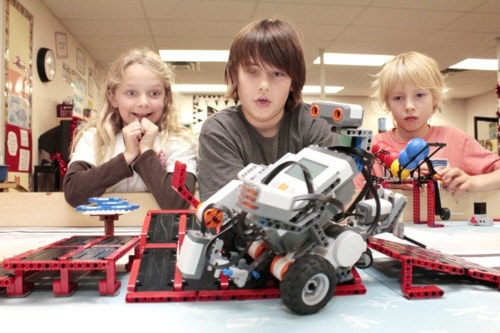A few smart kids from Nanaimo are tackling artificial intelligence from across the Island.
Members of Mountain View Elementary School’s Robotics Club are at the University of Victoria today pitting their problem-solving skills against competing Island robotics teams at the Vancouver Island First Lego League Robotics Competition.
First Lego League is a competition for elementary and middle school students that explores science and technology based on developing problem-solving skills related to real-world issues. The challenge for 2012 centres on how technology can help seniors suffering age-related issues such as mobility, dexterity and vision loss.
The Mountain View students, ages seven to 12, have been preparing for this year’s challenge for about two weeks through robotics sessions guided by Lincoln Silk with help from his wife, Michelle.
Silk has a degree in computing science and is the director of information systems for Nanaimo-based Ethos Career Management Group.
The children assemble their robot from kits produced by Lego Mindstorms, a Lego educational products division, and configure and program the robot for the challenge at hand.
“It comes with all the pieces and you put it together,” Silk said.
Each robot comes with a central processing unit with three ports that send signals to the robot’s drive and manipulator motors, plus four ports that receive signals from light, sound, pressure switch and ultrasonic range finding sensors. The combination enables the robot to navigate and perform tasks around a course set up on a standardized competition table. The children generate the robot’s set of instructions on a laptop computer using a building block style instruction assembly program with simple symbols representing commands the students string together.
“There are little menus and when they click on those, things pop up that represent little move blocks,” Silk said. “Gears represent a move, an hour glass is a ‘wait until’ command. They’re literally putting down a timeline telling the robot what to do and when.”
Once the children assemble the instruction code they test it to see how the robot performs on the competition table course, observe what goes wrong and when, iron out program bugs and fine tune the overall performance. The process requires patience, careful observation and develops problem solving skills.
“They’re learning what it’s like to program a really dumb machine because that’s what machines are – they have no intelligence,” Silk said.
All that programing and refinement will hopefully allow the children to start the robot and let it carry out its entire set of instructions on its course without human intervention. Throughout the last week Silk and the students crammed in as many sessions as possible to refine the robot’s performance for today’s competition.
“They push the button and the robot leaves and comes back on its own,” Silk said. “If they touch the robot somewhere [on the course] we lose points.”
The Mountain View team – only five to seven of the 15 students in the robot club are attending the competition – are up against teams within their age group category. Schools and home-schooled students are fielding teams at the competition.
